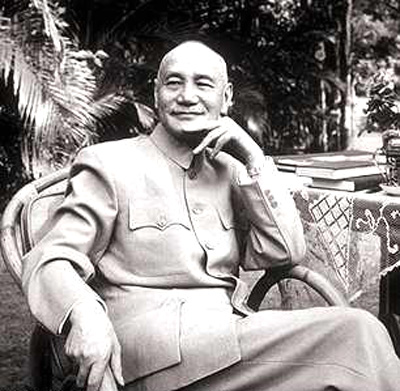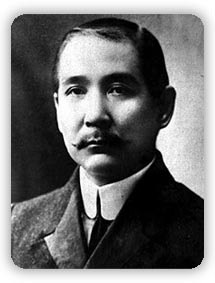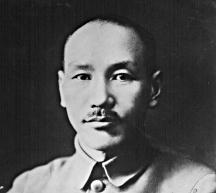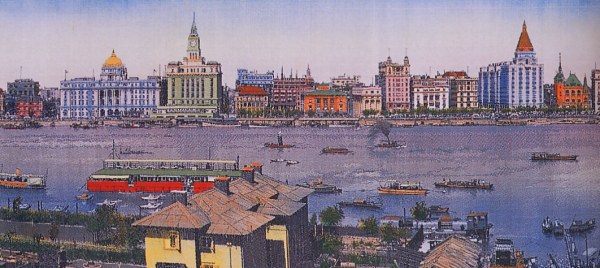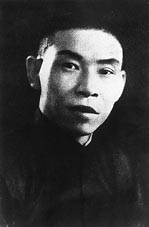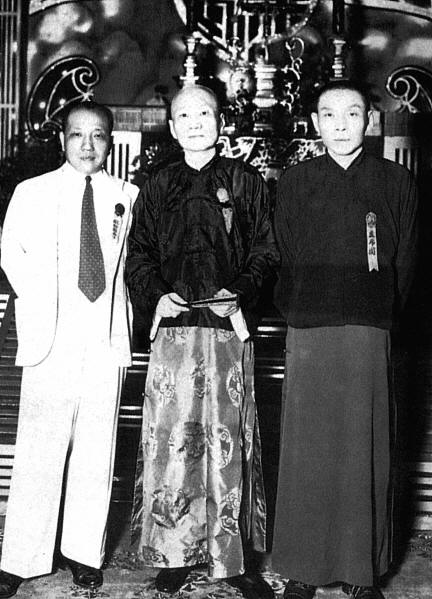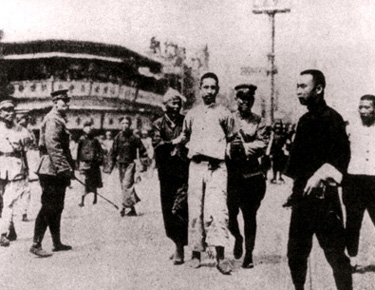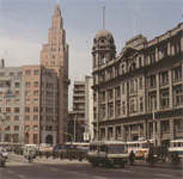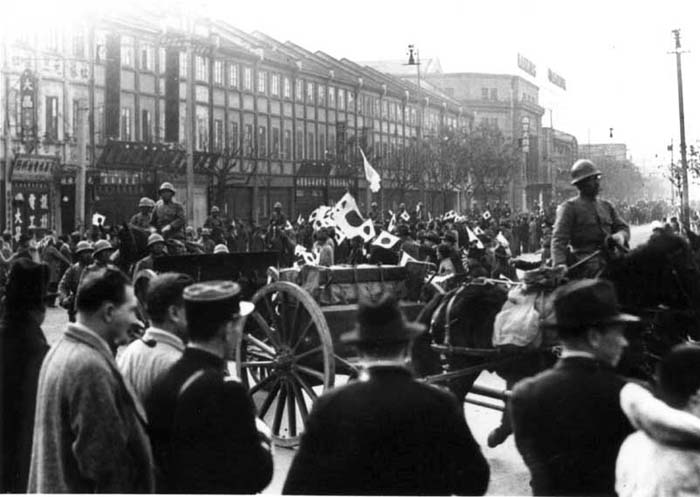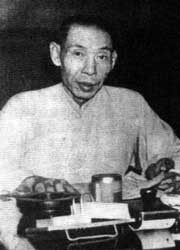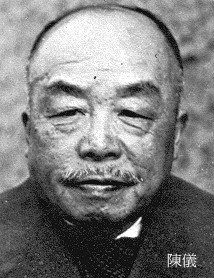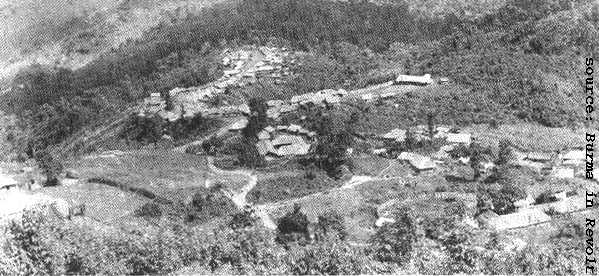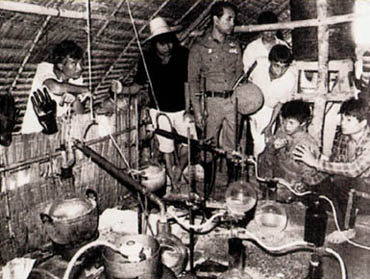|
||||||||
|
Chiang Kai-shek (1887 - 1975) |
||||||||
| Following the surrender of Japan in 1945, the island of Taiwan was given over to China or, more precisely, its putative government, the Nationalists or Kuomintang. The Kuomintang would subsequently become stranded on the island which they ruled for more than 50 years. | ||||||||
| The rise to power of China's Nationalist movement was closely linked with Shanghai’s eminence as an international drug capital. During the chaotic 1920s, warlord struggles for power and money accelerated the disruption and impoverishment of the country. Among the groups trying to reestablish a centralized state was the Kuomintang (KMT) or Nationalist party, whose objectives were at first more progressive than those of most of the warlord competition. In 1924 the KMT under Sun Yat-sen allied itself with the fledgling Chinese Communist party in order to strengthen itself politically and promote badly needed reforms. |
Sun Yat-sen in 1911 |
|||||||
| However, as Chiang Kai-shek gained power within the party after Sun's death in 1925, he began to break with the Communists and move toward an alliance with more conservative groups. During the Northern Expedition of 1926-1928 Chiang's KMT armies defeated warlord rivals thereby gaining support from the many people who demanded both an end to the chaos of warlordism and social reforms. | ||||||||
|
Chiang Kai-shek in 1920s |
Yet
the way in which Chiang took control compromised most of the KMT's
progressive ideals. Struggles with warlords often ended in coalition and
support in the countryside was sought from the old ruling class, the
gentry, so that the need for social reform
was ignored. Although Chiang never attained power over the
entire country, the Nationalists did become
established in China's major coastal cities, which remained their
primary base of support until the Japanese invasion of 1937. |
|||||||
| Foremost among these coastal cities was Shanghai, which had been an important Chinese center for the opium traffic since the 1840s, when Britain's victory in the Opium War opened the port to foreign trade and the establishment of foreign-controlled areas or concessions. | ||||||||
|
Shanghai in the 1920s |
||||||||
|
Chiang's
control of Shanghai was made possible with the aid of two main groups:
the wealthy and the criminal.
Wealthy merchants and foreign capitalists supported the KMT with the
understanding that there would be no reforms that threatened their
interests. The
Shanghai criminal organizations were dominated by two secret society
groups called the Green Gang and the Red Gang. During
the nineteenth century the Red and Green Gangs had drawn their
membership from people involved in transporting grain and smuggling salt
along the Grand Canal, China's primary north-south inland waterway.
However, after 1911 these groups had shifted their activities to the cities of
central China, and in particular to Shanghai, China largest and most industrialized
city. |
||||||||
| A young leader of the Green Gang, Tu Yueh-sheng, was to become one of Shanghai's most influential citizens. Tu, narcotics overlord and anti-Japanese patriot, began his career in Shanghai’s French Settlement, a noted center of illicit activities where criminals were permitted to operate freely. In exchange for tax profits on vice, the French turned the administration of the settlement over to the gangs. Tu became the protege of a man known as Pockmarked Huang, who was the chief of detectives in the French concession and a major Green Gang leader. |
Tu Yueh-sheng (1881-1951) |
|||||||
| Prior to 1918 Shanghai’s opium traffic had been based in the British concession, under the control of Swatow Chinese. However, after a 1918 crackdown on opium by the British authorities, the opium traffic was taken over by the Green Gang operating from the French concession. During the 1920s Tu Yueh-sheng unified the competing gangster organizations involved in the drug traffic and extended his influence from the French Settlement out to the more prosperous International Settlement. In the early 1920s Tu, known as the Opium King, was behind the production of 'anti-opium' pills, a supposed 'cure' for opium addiction that contained heroin, which sold by the million, so that one time the Shanghai syndicate was importing 10 tons of heroin annually from the West. | ||||||||
|
The leaders of the Green Gang in 1920s (Tu Yueh-sheng on right) |
||||||||
| Tu became one of the "Big Three" among the Shanghai gangsters. This unholy triumvirate controlled the city's underworld in early 1927, when Chiang's Northern Expedition forces were approaching. In late February 1927 labor unions allied with the KMT had moved against warlord control and foreign economic domination and begun a general strike, planning to welcome Chiang's armies to a liberated Shanghai. For his part, Chiang Kai-shek was actively courting the support of wealthy conservative and foreign businessmen; a strong united labour movement was a major impediment. Consequently, in late February, Chiang's forces delayed their advance toward the city, hoping that reprisals by the British-run International Settlement police and the Chinese garrison commander would break the strike and destroy its leadership. | ||||||||
|
|
||||||||
|
||||||||
| Following the Geneva Convention ban in 1928 on the marketing of heroin, the Shanghai traffickers set up their own refineries. They were so successful that in 1934 the Shanghai municipal council received a report that heroin was being more widely used than opium, and by then Shanghai had become a major exporter to the United States. | ||||||||
|
Tu's dominance of Shanghai had allowed the Kuomintang to destroy the communists in that city, but it had also forged an alliance between the Kuomintang and the drugs trade. The Ministry of Finance became dependent on the flow of funds from drug trafficking and yet it was never enough. In May 1935, while pursuing Communist troops in Yunnan, Chiang Kai-shek saw the opportunity to harvest the much-needed opium revenues from that province for the national treasury. By the end of the summer, the positioning of Kuomintang forces in Yunnan had brought the province into alignment with the Nationalists. The generalissimo followed similar tactics elsewhere to entrench Kuomintang authority and gain greater control over the opium business in the southwest and the Yangtze basin. By mid-July 1935, Chiang had turned most of the opium enterprises over to his ally, Tu Yueh-sheng. The Kuomintang jurisdiction in 1935 did not lead to opium suppression but brought instead stricter regulation of cultivation and sale, with the government monopoly providing revenue for Chiang from the city workers and poor farmers who "would rather go without food than without opium.” |
||||||||
| The Kuomintang's opium was sent down to Shanghai, where Tu supervised a comprehensive narcotics distribution network, whilst controlling all aspects of life from underworld operations to local government and municipal finances. As head of the Chung Wai Bank and chairman of the board of directors of the Commercial Bank of China, he easily financed his illicit dealings. Tu Yueh-sheng was now by far the most powerful man in China, and the Government itself had to count with his power. And in July 1935, Tu became a key member of the new Opium Suppression Commission, a tool that enabled him to ruthlessly suppress all independent operators under government sanction. |
Chung Wai Bank Avenue Edouard VII, Shanghai |
|||||||
|
Japanese troops enter Shanghai in 1937 |
||||||||
|
When the Japanese invaded Shanghai in 1937, Tu Yueh-sheng
pulled out and subsequently settled down in Chungking, where he became
known as a great philanthropist and headed several relief
societies.
In January 1942 the time was ripe for Tu Yueh-sheng to again go
into action in his particular line of business. Smuggling between
occupied and Free China had become so lucrative a business that the
Chungking government decided to step in and control it. It was arranged
for Tu Yueh-sheng to manage this trade with the enemy through the firing
lines, and five banks were ordered to finance Tu's new organization to
the tune of 150 million Chinese national dollars. Tu Yueh-sheng's cartel had crumbled when the underworld fled Shanghai. After World War II, as the Chinese revolution gathered momentum in the late 1940s, Shanghai's gangsters realized it was only a matter of time until the Communist forces would occupy the city. As most of the city's gangsters had participated in the 1927 massacre of Communist supporters, almost the entire underworld migrated en masse to Hong Kong from 1947 to 1950. This massive influx of thousands of China's toughest criminals was too much for Hong Kong police to handle, and organized crime flourished on an unprecedented scale. The Green Gang syndicate was a national organization, and its Hong Kong branch served as a welcoming committee. However, local gang leaders turned the situation to their advantage, and in the case of the Green Gang usurped the authority of their Shanghai bosses. |
||||||||
Following World War II, the Green Gang fell under the control of a Nationalist army lieutenant general, Kot Siu-wong. Kot had set up a new alliance, the Hong Fat Shan, in Guangzhou in the late 1940s as an anti-communist action group. The Hong Fat Shan subsequently became known as the “14K Society”. 14K members moved first to Hong Kong, Taiwan and Macao after the communist takeover of the mainland in 1949, and then dispersed further to Thailand, San Francisco, Vancouver, Manchester and Perth Australia. The "one-armed master chemist and his seven Green Gang disciples" escaped in 1949 from Shanghai to Hong Kong, where they trained the colony's chemists in the arts of heroin refining. This enabled Hong Kong to become a pivotal centre for the heroin trade in 1950s. The 14K was able to link the Kuomintang-controlled highlands of the Golden Triangle to the distribution channels of the USA and Europe. Tu Yueh-sheng also retreated to Hong Kong in 1949, where he died, aged 70, in 1951. |
Tu Yueh-sheng |
|||||||
|
Chen Yi |
Following the Japanese surrender of Formosa (Taiwan) to the control of the Kuomintang in 1945, Chiang Kai-shek sent Chen Yi to act as his governor. The new governor proved not to be the saviour that the Formosans were expecting as he set about a carpetbagging campaign of influence-peddling and pillage that would flavour Taiwan politics to the present day. One item of interest was the fate of the (Japanese) Narcotics Monopoly stocks. Although the Japanese government had not published narcotics figures since 1935, we can use these to guess the stockpiles remaining. | |||||||
|
It
is a matter of record that at the end of 1934 the Taiwan Monopoly Bureau
carried over a stockpile of 67,000 kgs of raw opium and 19,000 kgs of
prepared opium. At the end of 1935 it carried over a stockpile of
424,500 kgs of coca leaves, 6,060 kgs of crude morphine, and 1,250 kgs
of crude cocaine. Ten years later Chen Yi announced that the Japanese
had surrendered only 4,374 kgs of opium and "a small quantity"
of cocaine. These narcotics stocks, he said, had been promptly divided
into three parts; some had been released to the local Bureau of Health,
some had been sent to Nanking for use in the Army medical services, and
the balance had been destroyed. Henceforth, he said, the manufacture of
cocaine and coca derivatives would be given up. His agents had also assumed
control of the coca plantations in Taichung and near Taitung. |
||||||||
|
The Kuomintang, after their defeat by the Communists in 1949, fled in
two directions. One group, led by Chiang Kai-shek, escaped south from
Shanghai and via Hong Kong to settle in Formosa (Taiwan); the other group, led by
General Lee, escaped through Yunnan to settle in northern Thailand and Burma.
The intention was to retake China from Mao and the Communists in a two-pronged attack. This
never took place, but the remnants of the army in Thailand developed the
heroin trade. They were useful to the Thai government, and to the West,
who were pleased to have a fiercely anti-communist and well-armed group
patrolling the northern borders. They turned a blind eye to the heroin
trade, which consequently expanded. |
||||||||
|
Kuomintang base in Burma in 1950s |
||||||||
| With CIA support, the Kuomintang remained in Burma until 1961, when a Burmese army offensive drove them into Laos and Thailand. By this time, however, the Kuomintang had expanded Shan State opium production by almost 1,000 percent-from less than 40 tons after World War 11 to an estimated three hundred to four hundred tons by 1962. | ||||||||
|
||||||||
|
The
Hong Kong-based '14K' triad, with its strong links to the old Shanghai
Green Gang and Nationalist officers, was able to link the Kuomintang-controlled highlands of the Golden Triangle to the
distribution channels of the USA and Europe.
Whether the Kuomintang in Taiwan had any connection with this trade remains an open question. However, it can be assumed that Taipei had little incentive to risk the American aid that flowed in after the Korean War, and the American supply contracts that flooded in during the Vietnam War, launching Taiwan on its 'economic miracle'. |
||||||||
|
In the early 1990s, Taiwan came to notice as a transit point for Asian drug trafficking organizations moving heroin to the Western Hemisphere. The largest heroin seizure on record is the nearly half-ton of heroin that U.S. authorities discovered in Hayward, California in 1991. The drugs, which originated in China, had transited Taiwan en route to the United States. On 10 May 1993, Taiwanese policemen raided a fishing vessel entering Tungkang Harbour, 10 kilometers south of Kaohsiung, where they seized 336 kilograms of pure heroin smuggled from the Chinese mainland, with an estimated retail price of NT$10 billion (US$337 million). This was the largest single heroin seizure in Taiwan's history, and resulted in Taiwan being added to the Majors List in 1995. Taiwan's role as transit point for drugs destined for the United States, however, has changed radically in the past few years. More stringent law enforcement procedures, together with improved customs inspection and surveillance methods, have all but cut off serious flows of heroin from Taiwan to the United States. At the same time, the opening of major container ports in southern China has diminished Taiwan's importance for the drug trade. |
||||||||
|
||||||||
